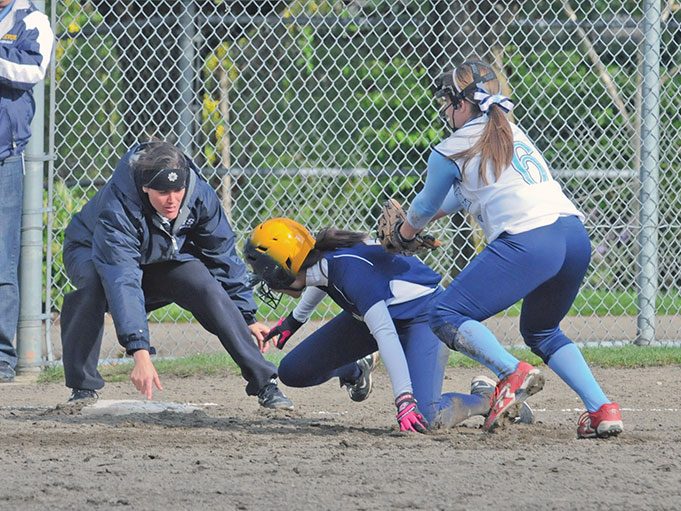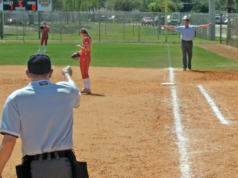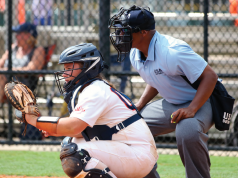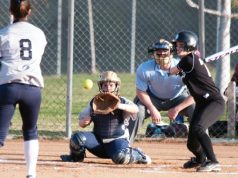From the very first camp that any official attends, what phrase is always uttered by clinicians and coordinators? “Get the call right!”
In 2018, that phrase took a new meaning for collegiate softball umpires. The methodology of how to go about getting to the correct solution changed. Crew members are now allowed to come in unrequested to reach the correct resolution.
In all other codes of softball, umpires make a judgment call. If the coach disagrees, the coach asks the calling umpire for assistance from another umpire. The fellow crew member would come forward with any pertinent and absolute information, thus giving the calling umpire the opportunity to change his or her call. The only time that a calling umpire would not go to his or her partner would be in the cases where he or she has 100 percent certainty that the correct ruling was made initially. That still happens today across the entire softball landscape.
Under the new philosophical model put forward in the CCA umpires manual, the non-calling umpire may give unsolicited information in the following cases:
- If a home run is fair or foul.
- Home run vs. ground-rule double.
- Foul tip vs. foul ball.
- Catch or no catch on a foul fly ball.
- Ball dropped or juggled on a tag or force play.
- Spectator interference.
- Interference by coach or on-deck batter on a foul fly.
- Coach assisting a runner.
- Catch and carry.
- Umpire jeopardy. (When an umpire’s inappropriate signaling causes incorrect actions by the teams. An example is ball four with a runner stealing from first base — catcher throws down and umpire calls out — runner jumps up and leaves the bag running to her dugout. Defense realizes it is ball four and tags her. The umpires’ actions caused inappropriate behavior by the runner. The runner would be placed back on second base and the batter-runner on first due to the base on balls on the play.)
- Definitive knowledge the calling umpire didn’t see his or her play.
While the list may seem lengthy, most of those plays were plays for which all umpires would seek assistance. However, there are a couple of notable differences. Starting in 2018, NCAA umpires are allowed to change a legally batted ball that is declared foul, but only on “dead-ball awards (i.e., out-of-the-park home run, ground-rule double, and hit-by-pitch)” (11.5.2 NOTE).
Note that doesn’t change the fact that a dead ball may never be “resuscitated back to life” but rather it acknowledges the ball is already dead and therefore the initial ruling may be corrected if necessary.
Another notable difference is in the knowledge of a crew member seeing the play on which he or she is ruling. That is actually a more common situation than you might think and one that, if executed properly, can be a real crew-saver. Below is an example of how that could come into play:
Pickoff play at first base. U1 calls R1 out. PU clearly sees that F3 did not have possession of the ball upon applying the tag on R1.
In that scenario, PU had definitive knowledge. U1, although in correct position to judge the play, simply couldn’t see the ball come out of the glove as it was on the other side of a sliding R1’s body and F3’s glove. By PU coming in and offering the vital information, that example of crewness is vital to managing the game properly and confidently.
“But I don’t work NCAA!” you exclaim. Everything written above is written as guidelines when working NCAA games, or games that use NCAA rules. What about USA Softball or NFHS or any other code that you might work? Could those principles work in those games as well? Mostly, yes.
While not explicitly written in any other umpire manual, the goal of umpires has always been to get the call right. For years, all codes have allowed for situations in which the crew can come together to render a correct resolution to all plays. However, the difference now is in the process and philosophy. While the NCAA is allowing umpires to offer unsolicited information in specific instances, the other codes still do not have that language in their manuals, nor is it taught at any of their sanctioned camps and clinics.
So take that same pickoff situation described earlier. Could the umpires in a game using any other code of play follow the same procedure? I submit that, even though it is not directly spelled out in a manual that says you can, there is also nothing stated that you can’t, either. Remember though, each manual and each rule set is written to address that desired audience.
My suggestion? Pregame it with your crew. If you have definitive knowledge, give a look or a small tell that only you and your crew know. In the non-collegiate game, if an umpire were to follow the NCAA process on that play, it may look like the PU is “dominating” the other umpire(s), thus creating a situation in which crew credibility takes a hit. It looks better in those instances for the calling umpire to seek out assistance of the crew.
Getting the call right is always of paramount importance. There is never a substitute for proper rules and mechanics knowledge, nor is there ever a substitute for standing up for your own call and/or judgment in all situations. Yet umpires must understand and be willing to seek, offer and accept information that may be crucial to getting the call correct and help the crew gain credibility.
What's Your Call? Leave a Comment:
Note: This article is archival in nature. Rules, interpretations, mechanics, philosophies and other information may or may not be correct for the current year.
This article is the copyright of ©Referee Enterprises, Inc., and may not be republished in whole or in part online, in print or in any capacity without expressed written permission from Referee. The article is made available for educational use by individuals.


















